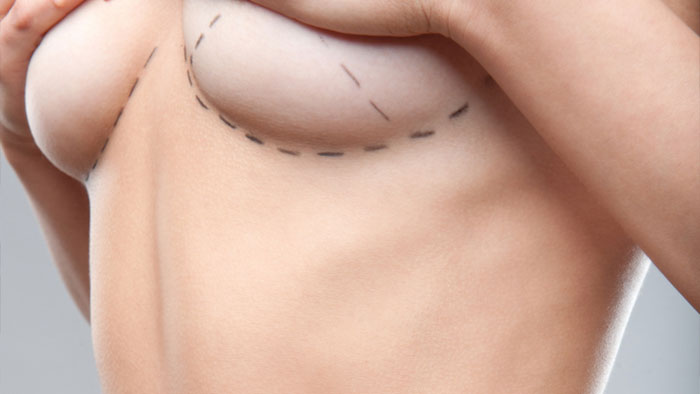Expander Implant Reconstruction
Post mastectomy reconstruction with a tissue expander and implant involves a staged approach.

A tissue expander is a temporary device that is placed on the chest wall deep to the pectoralis major muscle. This may be done immediately following the mastectomy, or as a delayed procedure. The purpose of the expander is to create a soft pocket to contain the permanent implant. Tissue expanders are available in a variety of shapes and sizes.
At the time of the initial post mastectomy reconstruction operation, when it is first positioned on the chest wall, the tissue expander is partially filled with saline. Within a few weeks after this surgery, once the patient has healed, expansion can be started as an office procedure. The process of expansion takes place at one, two or three week intervals over several months. The timing of expansion can be coordinated with chemotherapy treatments. The amount of fluid that is placed into the expander at the time of the initial surgery will also determine how many expansions are later required. Today, with the use of a dermal matrix, the surgeon can usually place a higher volume of saline during the initial surgery. This may decrease the number of expansions needed later. The patient will be well on her way to having an immediate breast shape after the first operation.
Most expanders have a fill port that is built into the front of the device. This port is accessed with a needle through the skin. Expansion takes about one minute, and the amount of fluid that is placed is limited by the tightness of the patient’s skin. A typical volume for each expansion procedure is 50 cc's of saline (an equivalent of 10 teaspoons). Most patients do not have significant discomfort or pain after expansion. Discomfort can generally be managed with Tylenol, and the tightness should subside within 24 hours.
Once expansion is completed and the patient is medically cleared for another operation (about one month after chemotherapy), the second stage of reconstruction is performed. This is an outpatient procedure that involves exchanging the expander for an implant, and creating a more refined breast shape. The initial tissue expander placement, and subsequent exchange for an implant, each take about one hour in the operating room.
Together with your surgeon, you will decide which implant best suits your individual needs. Once a patient has completed her exchange, she will immediately feel more comfortable than she did with the tissue expander. The degree of tightness and discomfort should continue to decrease once the implant has settled and healed. In two to three months, the next stage of surgery will be performed to reconstruct the nipple areola. If desired, additional contouring procedures, such as fat injections, can be performed to adjust breast shape at this third stage. In some patients, further contouring and shaping procedures may be needed. For patients with a unilateral breast reconstruction, it is very common to require an adjustment procedure on the opposite breast (such as an augmentation, reduction, or lift), in order to achieve better symmetry. For patients undergoing bilateral reconstruction, symmetry using implants is easier to achieve.
You are an ideal candidate for expander implant post mastectomy reconstruction if you:have no available flap options, do not desire a flap operation, do not have compromised tissue at the mastectomy site, have no history of previous radiation to the breast or chest wall, are having prophylactic mastectomies, want bilateral reconstruction, are of a reasonable size and body weight, agree to have an operation on the opposite breast to help improve symmetry.
You are not an ideal candidate for expander implant post mastectomy reconstruction if you have: compromised tissue at the mastectomy site (numerous surgeries or infection), been previously radiated (refer to effects of radiation), advanced disease, autoimmune disease (may be a contraindication for gel-filled implants), a Body Mass Index greater than 30.
The above mentioned characteristics are considered relative contraindications for the use of tissue expanders because each is associated with a higher risk of complications. This does not rule out the use of expanders and implants in all patients with these conditions.
KEY POINTS OF THE OPERATION
- Post mastectomy reconstruction with a tissue expander and implant is performed exclusively under general anesthesia.
- Duration of surgery: 1 – 1.5 hours.
- Stay in hospital: 1 day.
THE REHABILITATION PERIOD
- After tissue expander reconstruction, you may wake up feeling groggy as you awaken from the anesthesia.
- You will be on pain medication, and usually have two drains for each breast that are under your skin and exit from your underarms.
- You will be wrapped in a post surgical bra which may feel tight across your chest, and you may have limited arm mobility.
- This pain should become easier to manage within a few days.
- The sooner you are up and slowly moving around, the sooner you can go home and recover in the peace and quiet of familiar surroundings.







